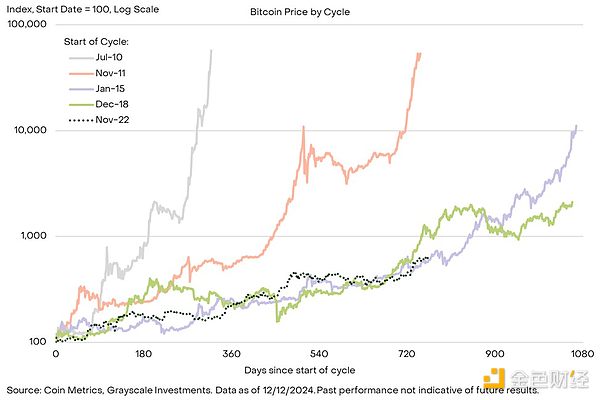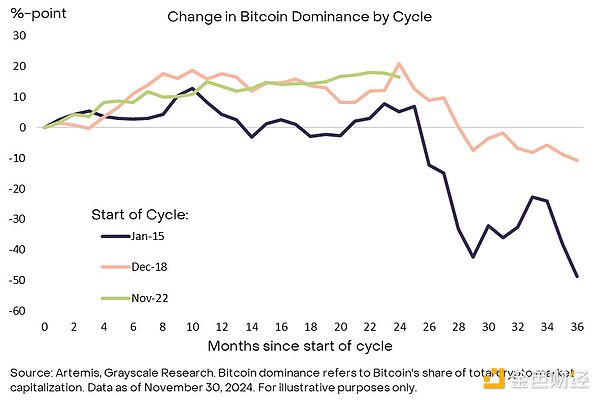Author: Zach·Pandl, Michael·Zhao, Grayscale Research; Translated by 0xjs@Jinse Finance
Key Points:
● From a historical perspective, cryptocurrencies have exhibited a clear four-year cycle, going through consecutive stages of price increases and decreases. Grayscale Research believes that investors can monitor various blockchain-based metrics and other benchmarks to track the crypto cycle and inform risk management decisions.
● Cryptocurrencies are maturing as an asset class: New spot Bitcoin and Ethereum ETPs are expanding market access, and the incoming U.S. Congress may provide clearer regulation for the industry. Given these factors, cryptocurrencies may eventually break out of the distinct four-year cycle that has characterized the early market.
● Nevertheless, Grayscale Research assesses that the current set of indicators aligns with the mid-stage of the cycle. As long as the fundamentals remain solid, such as widespread adoption and a favorable macroeconomic environment, the bull market could extend into 2025 and beyond.
Similar to many physical commodities, Bitcoin's price does not strictly follow a "random walk" pattern. Instead, its price exhibits statistical momentum: it tends to continue rising after increases and continue falling after declines. Viewed over a longer time horizon, Bitcoin's cyclical fluctuations oscillate around an upward trend line (Figure 1).
Figure 1: Bitcoin's price exhibits cyclical fluctuations around an upward trend

The drivers of past price cycles have varied, and future price returns may not replicate past experiences. As Bitcoin matures, gains more acceptance from traditional investors, and the supply impact of the four-year halving event diminishes, its price cycle may be reshaped or even disappear. However, examining past cycles can help investors understand Bitcoin's typical statistical characteristics and aid in risk management.
Measuring Momentum
Figure 2 shows Bitcoin's price performance during the upward phases of the previous few cycles. The prices are indexed to 100 at the cycle low (marking the start of the appreciation phase) and tracked to the peak (marking the end of the appreciation phase). Figure 3 presents the same information in tabular form.
Bitcoin's early cycles were short and saw rapid appreciation: the first cycle was less than a year, and the second was around two years. Both saw prices surge over 500x from the prior cycle low. The latter two cycles were each close to three years. The cycle from January 2015 to December 2017 saw Bitcoin appreciate over 100x, and the cycle from December 2018 to November 2021 saw an appreciation of around 20x.
Figure 2: The trajectory of the current cycle resembles the previous two Bitcoin market cycles

After peaking in November 2021, Bitcoin's price fell to around $16,000, the cycle low, in November 2022, marking the start of the current cycle, which is now over two years old. As shown in Figure 2, the price appreciation in this cycle is similar to the trajectories of the previous two Bitcoin cycles, both of which required an additional year to reach their price peaks. In terms of magnitude, this cycle has seen an appreciation of around 6x, which is substantial but far less than the previous four cycles. Overall, while the future price trajectory may not precisely match past cycles, history suggests that this bull market has room to expand in both duration and magnitude.
Figure 3: Four distinct Bitcoin price cycles in history

Checking Key Metrics
In addition to analyzing past cycle price trajectories, investors can use various blockchain metrics to gauge the progress of the Bitcoin bull market. Common metrics include the appreciation of Bitcoin buyers' cost basis, the scale of new capital inflows, and the relative levels of price and Bitcoin miner revenues.
One widely followed metric is the ratio of Bitcoin's market value (MV, calculated using secondary market prices per coin) to its realized value (RV, calculated using the most recent on-chain transaction prices per coin), known as the MVRV ratio, which can be seen as the degree to which Bitcoin's market value exceeds the market's total cost basis. In the past four cycles, this ratio has reached at least 4 (Figure 4). The current MVRV ratio is 2.6, suggesting this cycle may have further to run. However, the peak MVRV ratio has been declining across cycles, and it may not reach 4 before the price tops out.
Figure 4: The MVRV ratio is at a mid-range level

Other on-chain metrics consider the degree of new capital inflows into the Bitcoin ecosystem, which crypto investors often refer to as "HODL Waves." Price appreciation may be driven by new capital bidding up coins from long-term holders. Among the many metrics, Grayscale Research favors the ratio of the one-year on-chain transfer volume to the total circulating supply (Figure 5). In past cycles, this metric has reached at least 60%, meaning that at least 60% of the circulating supply changed hands during the appreciation phase. Currently, it is around 54%, suggesting we may see further increases in on-chain turnover before the price peaks.
Figure 5: The one-year Bitcoin transfer volume activity is below 60%

Another set of cycle metrics focuses on Bitcoin miners, the professional service providers that maintain the Bitcoin network. A commonly used one is the ratio of miner market capitalization (MC, the dollar value of miners' Bitcoin holdings) to the "thermal cap" (TC, the cumulative value of Bitcoin earned by miners through block rewards and transaction fees). The rationale is that when miner assets reach a certain threshold, they may be inclined to realize profits. Historical data shows that when the MC/TC ratio exceeds 10, the price has typically peaked within the cycle (Figure 6). The current ratio is around 6, indicating the cycle is in the mid-stage. However, similar to the MVRV ratio, the peak MC/TC ratio has been declining across cycles, and the price may top out before reaching 10.
Figure 6: Miner-based metrics are also below historical thresholds

There are many on-chain metrics, and data sources may differ. Moreover, these tools can only roughly gauge the current price appreciation phase relative to past cycles, and the relationship between the metrics and future price returns may not be constant. Overall, the common Bitcoin cycle metrics remain below their historical peak levels, suggesting that the current bull market may continue if the fundamentals remain solid.
Beyond Bitcoin: Other Cryptocurrencies
The crypto market extends far beyond just Bitcoin, and signals from other areas of the industry can also inform the market cycle outlook. Given the relative performance of Bitcoin and other crypto assets, such indicators may be particularly crucial in the coming year. In the past two market cycles, Bitcoin's dominance (its share of the total crypto market capitalization) peaked around the two-year mark of the bull markets (Figure 7). Its dominance has recently declined, coinciding with the two-year mark of the current cycle. If this trend continues, investors should consider a broader set of indicators to assess whether crypto valuations are approaching a cycle peak.
Figure 7: Bitcoin's dominance started declining in the third year of the previous two cycles

For example, investors can monitor the funding rate, the cost for holders of perpetual futures contracts to maintain their long positions. High demand for leveraged trading by speculators drives the funding rate up. The weighted average funding rate for Bitcoin and the top 10 Altcoins can thus gauge the overall speculative long positioning in the market (Figure 8). The current funding rate is significantly positive, indicating robust demand for leveraged long positions, although it dropped sharply during last week's market selloff. Even at this local peak, it remains below the levels seen earlier this year and the previous cycle's peak. This suggests a moderate degree of speculative long positioning, still far from a cycle top.
Figure 8: Altcoin funding rates indicate moderate speculative long positioning

In comparison, the open interest (OI) of Altcoin perpetual futures contracts has risen to a high level. On Monday, December 9, before the large-scale liquidation, the Altcoin OI of the three major perpetual futures exchanges was close to $54 billion (Figure 9), highlighting the high speculative long positions in the market. After the large-scale liquidation at the beginning of this week, the OI has dropped by about $10 billion but is still at a high level. The high speculative long positions are in line with the characteristics of the late stage of the market cycle, so continuous monitoring is needed.
Figure 9: The open interest of Altcoin was at a high level before the recent liquidation

Keep the Music Playing
Since the birth of Bitcoin in 2009, the digital asset market has developed by leaps and bounds, and this round of the cryptocurrency bull market is different from the past in many ways. The key is that the approval of Bitcoin and Ethereum spot ETPs in the US market has led to a net inflow of $36.7 billion, driving their integration into traditional investment portfolios. Moreover, the recent US election is expected to improve the transparency of market regulation and consolidate the position of digital assets in the world's largest economy, a profound transformation that has long been questioned about the long-term prospects of cryptocurrency assets. Therefore, the valuation of Bitcoin and other cryptocurrencies may not repeat the early four-year cycle.
At the same time, cryptocurrencies, like digital commodities, may have momentum characteristics in their prices. Therefore, analyzing on-chain indicators and Altcoin position data can provide investors with valuable input for risk management decisions.
Grayscale research suggests that the current indicator combination is in line with the mid-term stage of the cryptocurrency market cycle: the MVRV ratio is higher than the cycle low point, and still far from the previous market top. As long as the fundamentals are solid, such as widespread adoption and a favorable macroeconomic environment, the cryptocurrency bull market has no reason not to continue until 2025 and beyond.






